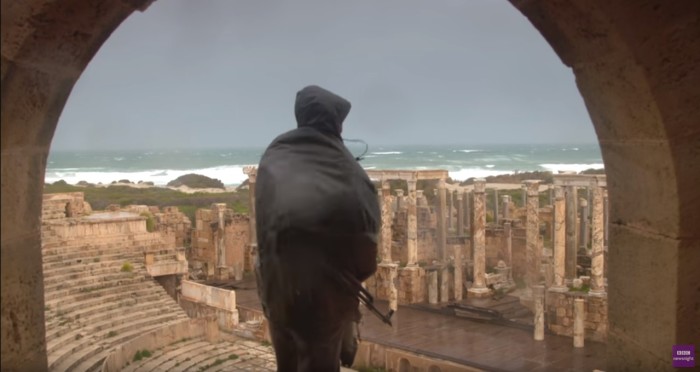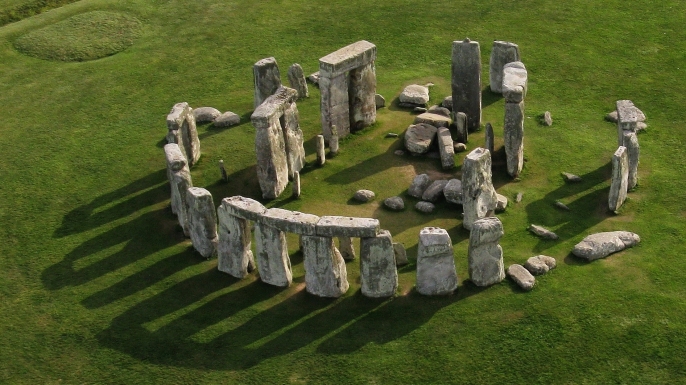3rd March 2016 Tripoli, Libya
A Nation In Ruins
A few weeks ago a BBC journalist visited Leptis Magna, on the coast east of Tripoli. It contains the remains of one of the most spectacular cities of the Roman Empire with its imposing public monuments, harbour, market-place and residential district.
The report included a picture of a lone man standing guard over the ruins. He continues in spite the continuing conflict, the lack of tourists and the threat of Daesh. He carries an old rifle to defend the site.

Ruins are certainly part of national identity. The pyramids in Egypt, Petra in Jordan, the Acropolis in Athens: all tell stories of a glorious past. That history is taught at schools and instils a sense of nationhood and a search for future glory.
In Britain, Stonehenge, a 4,000 year-old stone circle demonstrates that our ancestors were scientifically sophisticated, capable of transporting huge blocks for hundreds of miles and erecting them in a complex pattern that matched the movements of the sun. That too is a source of national pride.

Daesh have already shown that they have no respect for ancient history or cultural heritage. In Syria, they not only blew up the 2,000 year old temple of Baalshamin in Palmyra, they murdered the 82-year old archaeologist who had dedicated his life to investigating and understanding the site.
According to UNESCO: “the systematic destruction of cultural symbols embodying Syrian cultural diversity reveals the true intent of such attacks, which is to deprive the Syrian people of its knowledge, its identity and its history.”
Maybe the guard at Leptis Magna wants to prevent such an act of barbarism. Another possible motivation is that these ancient ruins are valuable to the economy. Tourists like to clamber over old stones and take photos of ancient temples and columns. They can be a source of employment and a place where local handicrafts can be sold.
I truly hope that Libyans will not allow Daesh’s fanaticism and criminality to destroy thousands of years of cultural heritage in Libya. The many sites dotted round the country, whether Roman or Greek are a source of pride to the Libyans I have met. They too are concerned by what Daesh might do if they got their hands on them.
Of course, many will say that people are more important than old stones: that the thousands of Libyans who have been displaced and forced to live in schools or other temporary accommodation should be the priority.
That is certainly true. No-one would expect a Government of National Accord to make the protection of antiquities one of the top priorities for its first 100 days. Improving security for people, getting the electricity running, regenerating the economy will all – rightly – be the priorities.
But protecting Libya’s heritage as a symbol of the nation’s history can help to reunite the country and restore a sense of pride in Libyan identity.
So I hope that someone will remember the lone guard at Leptis Magna, ensure that he is properly rewarded for his efforts and has the equipment necessary to continue to guard the site. Better a nation intact than in ruins.
Dear Mr Millett
You rightly raise this highly important matter. I visited Leptis and Sabratha c. 1992 and was greatly impressed.
You say that you “hope that someone will remember the lone guard at Leptis Magna, ensure that he is properly rewarded for his efforts and has the equipment necessary to continue to guard the site”. I don’t disagree. However, what is the British government doing? Precious little, as far as I can see. Have you been pressing the case for protection with the FCO?
I raised this matter with my MP, Alex Chalk, suggesting that, as, unlike Palmyra, Leptis Magna and Sabratha are right on the coast, and hence readily accessible to Western forces, the British government should be taking action to protect the sites, in conjunction with its allies. I said that it seemed quite straightforward to secure the sites by military intervention to create secure areas around them, and that the UN would surely sanction such an intervention to save these antiquities, given their listing by UNESCO as World Heritage sites.
Mr Chalk’s reply indicated that he takes the matter seriously (making reference to the 1954 Hague Convention for the Protection of Cultural Property in the Event of Armed Conflict) but gave little hope of positive action by the government.
The Spectator’s September 2015 article (http://www.spectator.co.uk/2015/09/meet-the-men-taking-up-arms-to-protect-the-middle-easts-ancient-treasures) seemed to have it right when it wrote of the “hand-wringing done by western politicians”, the “distinctly iffy track record [of the West] on protecting our cultural heritage” and said that “we in the West should be ashamed not to have done more to help” the locals doing their best to protect the great sites.
Must we resign ourselves to fate, in the knowledge that Western governments will do nothing?
Kind regards
Tim Smith
I think the lone guard is a very brave man. I wonder if Sabratha’s Roman remains and Vila Siline and the Greek and Roman remains in the East have equivalent guards . We visited Leptis Magna about 20 times during our two year residence in Libya 2009 to 2011.
Visited there several times on my way to work at Ras Lanuf many years ago. It’s absolutely fantastic, and either the largest or one of the largest Roman ruins outside of Italy. I had always hoped to be able to re-visit them one day – but unfortunately it looks like I’ll just have to rely on my memories and the many many pictures that I took whilst visiting. Let’s hope that Leptis is still there unmolested in another 100 years time for all to see.